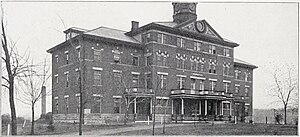
George R. Smith College was a historically Black college located in Sedalia, Missouri, it was attended by ragtime composer Scott Joplin, who was famous for the piano music piece "Maple Leaf Rag."
History
The institution was associated with the Freedmen's Aid and Southern Education Society of the Methodist Church and played an important role in the lives of young people for several decades.
According to the Encyclopedia of the History of Missouri edited by Howard L. Conard, the building was completed in 1882. The college operated from 1894 until it burned down in April 26, 1925, after which its assets were merged with the Philander Smith College in 1933. A photograph of George R. Smith College, with students, can be found among at the State Historical Society of Missouri.
Notable alumni
Main page: Category: George R. Smith College alumni- Myrtle Craig Mowbray, first African American woman to graduate from Michigan State University, in 1907
- Scott Joplin, ragtime music piano composer
- Arthur Marshall, ragtime composer and contemporary of Scott Joplin
- Homer G. Phillips, prominent lawyer and civil rights advocate
- T. Manuel Smith, president of the National Medical Association (1942 to 1943)
Presidents
- P. A. Cool, 1894–1897
- E. A. Robertson, 1897–1902
- I. L. Lowe, 1902–1907
- A. C. Maclin, 1907–1910
- J. C. Sherrill, 1910–1912
- George Evans, 1912–1914
- Matthew Simpson Davage, 1914–1916
- Robert B. Hayes, 1916–1925
Athletics
Throughout the history of the college, various men and women's sports teams were fielded. Athletic teams from George R. Smith were known as the Deweys. Their colors were purple and white. Men had the opportunity to play football, baseball, basketball and tennis, while women could participate in sports such as basketball, tennis, croquet, and swings.
The 1903 George R. Smith Deweys football team won the HBCU football championship of Missouri. In the championship-deciding game, the Deweys defeated the Lincoln Blue Tigers of Jefferson city by a score of 17-0, although the game was reportedly brutal and controversial.
References
- "George R. Smith College". Tagwhat story. Archived from the original on March 3, 2016. Retrieved April 22, 2015.
- Link to the Encyclopedia of the History of Missouri (1901)
- Nolen, Rose M. (February 4, 2010). "Nolen: Black residents were key in city's growth". Sedalia Democrat. Archived from the original on July 16, 2011.
- "Soul of America article on Philander Smith College". Archived from the original on July 16, 2011. Retrieved February 15, 2010.
- Photograph of George R Smith College and students (c. 1900) Archived November 3, 2012, at the Wayback Machine State Historical Society of Missouri
- Widder, Keith R. (2005). Michigan Agricultural College: The Evolution of a Land-Grant Philosophy, 1855-1925. East Lansing: Michigan State University Press. pp. 94, 346–348. ISBN 0870137344.
- "Scott Joplin (c. 1868 – 1917)". State Historical Society of Missouri. Archived from the original on September 15, 2017. Retrieved March 16, 2017.
- "Accosted On Corner, Prominent St. Louis Attorney Is Killed By Unknown Gunmen". The Black Dispatch. St. Louis. Associated Negro Press. June 25, 1931. pp. 1–2.
- "The Incoming President". Journal of the National Medical Association. 34 (5): 177. 1942. PMC 2625055. PMID 20893114.
- "George R. Smith College Sedalia, Missouri 1888-1925". Lost Colleges.
- "N/A". Saint Louis Republic. November 22, 1903. p. 32 – via Newspaperarchive.com.
External links
- African American Methodism and Higher Education in Missouri
- The Biggest Little Black College on the Prairie
38°43′N 93°13′W / 38.72°N 93.22°W / 38.72; -93.22
Categories:- Defunct private universities and colleges in Missouri
- Historically black universities and colleges in the United States
- Buildings and structures in Pettis County, Missouri
- Education in Pettis County, Missouri
- George R. Smith College
- Universities and colleges established in 1894
- Educational institutions disestablished in 1925
- Sedalia, Missouri